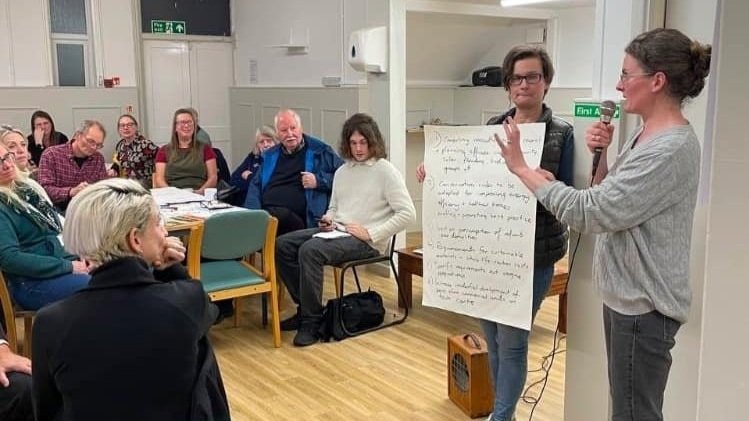
Alternatives to New-Build
Grace Lally, housing campaigner, spoke about Alternatives to New-Build
Environment v Housing Need?
Environment INCOMPATIBLE with housing for profit
Meeting housing NEED and protecting environment have the SAME solutions.
Why do we NEED to build new housing?
New housing is more environmentally sustainable - NOT TRUE
We have a shortage of housing - NOT TRUE
More housing reduces prices - NOT TRUE
REAL reasons to build new housing?
New housing creates economic growth, investment opportunities and profits - TRUE - but who benefits? And at what cost?
We need private development and private landlords because we can't afford to provide housing with public money - NOT TRUE
Myth 1: New houses are more sustainable
'The greenest building is the one that already exists' (Carl Elefante, former president of the American Institute of Architects).
New building - Lower operational Greenhouse Gas (GHG) - less energy to heat and light - but construction (embodied GHG) is 50% GHG emissions over its life-cycle.
Construction is 10% of overall UK carbon emissions.
Future Homes Standard (FHS) in 2025 does not include regulating embodied carbon.
Other environmental impacts of construction
Green spaces, plants and wildlife, water contamination, air pollution, resource depletion (sand is running out!), flooding, increased car use, loss of carbon sinks.
New houses CAN be sustainable but we need much higher building regulations and materials standards to achieve this.
But we can't build our way to sustainable housing.
Only 40% rated C or higher - 29 million homes in the UK need to be retrofitted before 2050 to meet the country's net zero target.
Myth 2: We have a shortage of housing
Over 1 million empty homes.
500,000 second homes + unused & holiday lets.
Increasing number of homes per person:
1971 - almost one dwelling for every three people.
2024 - one dwelling for every 2.25 people.Increasing number of rooms per person:
1.8 uk (OECD average 1.6).
Not a housing shortage crisis - a hoarding crisis
Growing inequality in DISTRIBUTION of homes and rooms:
In 1991 the richest 10% of people had about three times more rooms per person than the poorest 10%. By 2011 - it was five times.
2001 - 757,000 more dwellings than households.
2019 - 1.2 million more houses in England than there were households.
2021 - 1.4 million more dwellings than households in England.
2023–2024, 178,560 households were homeless ( 12.3% increase from 2022-23).
Myth 3: More housing reduces prices
Ratio of houses to households has been falling steadily for 50 years.
We ARE building more houses but house prices are still rising:
2018 to 2021: Surplus of English homes increased 1.2 to 1.4 million - Average prices rose by 14%.
2000 to 2022 - average cost of housing rose by 314%.
Are we just building them in the wrong place?
London 2012-2022: Twice as many new homes as new households.
Average property values increased 76% (115% in Barking & Dagenham).
Does Gov actually WANT to reduce prices?
House prices rise with supply of money and credit, not supply of houses.
Rising prices makes it MORE desirable, does not reduce demand.
1 in 21 people are now landlords (more secure than pension?).2014 - 2016: 13% all homes bought in London bought by overseas investors.
Almost half of all bank assets in the UK are tied up in property.
What's the solution to the housing and climate emergency?
Take housing out of the market - housing as a right not a commodity.
Massive public investment to redistribute housing fairly.
Massive public investment to upgrade existing homes.
Democratic control of planning to meet housing need and protect environment.
Myth 4: We can't afford green public housing
Council housing is not subsidised.
Cheap rent reflects true cost of housing - maintaining and repairing it.
Private landlords are subsidised - 2021 to 2026 - 70bn pounds in housing support payments to private landlords (v 11.5 billion pounds government's total spend on Affordable Homes Programme)
Private developers are subsidised. No land value tax, no vat on new builds, grants for cladding remediation, AHP grants to for-profit providers.
.. we can't afford not to
Public money already has to pay for the effects of the housing crisis:
In 24/25 in Hastings alone 6.7 million pounds on temporary accommodation (TA) - mostly going to private landlords ('wrong and immoral', said TA worker).
Damp and cold homes - 1.4 billion cost NHS, 18.4 billion cost wider society (BRE report 2021).
And the climate crisis:
e.g. flooding, infrastructure, agriculture, health, insurance, forced migration.
